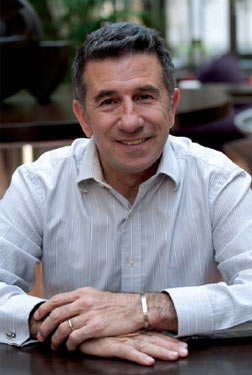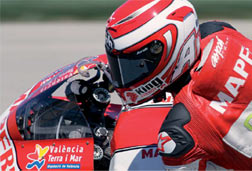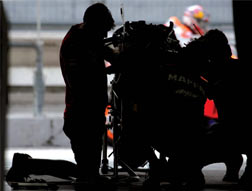Interview with Jorge Martínez “Aspar”. Aspar Team ManagerMiscellaneous
The world of motorcycling caught him very early on. When he was only seven years old, Jorge Martínez “Aspar”1 was already dreaming of getting on a motorbike and would run away from home to “hit” two wheels with his older brother’s gang. The opportunity soon arose and he did not miss it. In 1979 he ran his first race on a four-speed Derbi, which he still has, and finished second.
The dream had started to come true. Two years later, he won his first Spanish Championship title and, after signing a contract with Metrakit, made his first appearance on the World Championships podium. The arrival of the Derbi brand in his life, in 1984, finally launched his career, and from then on it became unstoppable, although there will always be a place in his memory for his first victory in the Dutch Grand Prix, in the 80cc class.
In 1985 he managed to win the Spanish Grand Prix held at the Jarama Circuit, and in 1986 his first World Championship title, retaining his crown in subsequent years. In 1988 he achieved the “double” by winning in both the 80cc and the 125cc classes.
His last season with Derbi, in 1989, was quite complicated because it was accompanied by various injuries and mechanical breakdowns. The following year, he embarked on the JJCobas Project to compete in the 125cc and 250cc classes, first with a Rotas and then with a Honda engine, but things did not turn out quite as well as he hoped, although he did win some important titles. Then in 1992, still as a rider, he decided to set up his own team with an eye to the future. The Aspar Team had been born.
After a few difficult years and some brilliant but sporadic performances in the 250cc class, in 1994 Aspar continued his career riding a smallcapacity Yamaha on which he won his final Grand Prix, in Argentina. After that, he began his stint with Aprilia and won the European Championship title. In 1997, he finally hung up his motorcycling kit, ending his career as a rider to concentrate on the team that he had created so as not to give up his dream: the world of two wheels.





“Spanish motorcycling is an example to the world which we have to look after”
“Fortunately, within motorcycling there have been important changes in the area of safety, both on the street and in racing”, says Jorge Martínez “Aspar”. He is a legend in the world of two wheels, in which he continues to be involved as Manager of the Aspar Team, which he describes as “a close-knit big-image team in which the riders feel very much at home”.
Today, how do you remember your first race in 1979?
I bring it to mind with a great deal of nostalgia. I was a child and was really excited about racing and, of course, winning. But at that time, I never imagined that I could end up being World Champion. The truth is that, back then, motorcycling was nothing like what it is today. The world of two wheels was frowned upon; many people thought it was just about a few madmen who raced motorbikes, but the great Spanish riders have shown quite the opposite: that a motorcycle rider has to be very sane not only for racing, but for racing, not falling off, servicing his bike, talking to technicians, engineers and the press. And the truth is that I will never forget that first race, any more than I will the other competitions throughout my sporting life.
A motorcycle rider has to be very sane, not only for racing, but for racing, not falling off, servicing his bike, talking to technicians, engineers and the press
What do you miss about your time as a rider?
Lots of things. It was all great fun. I was doing something I liked. I consider myself very lucky, because from 1979 to 1997, when I retired, I was competing at the world level and achieved more sporting success than I ever thought possible. I remember very well all the things that happened during that time, the good as well as the bad, like the falls.
A fighting and winning spirit
When a rider is on the track, what does he think about?
When I was competing, all I thought about was racing, racing and racing; and of course about winning, winning and winning. I have always been a fighter and a winner, and when I got onto the track what I wanted to do was give 100% and achieve a victory.
Your career focused mainly on the 125cc class.
Times were different then. In the eighties, being able to compete in the 250cc class was a dream, and in the 500cc class something impossible. Fortunately, everything has changed and there are great Spanish riders who have reached the 500cc or MotoGP class, and we are leaders in any class; but in those years it was very complicated.
What do you think about the first bend of the Cheste Circuit bearing your name? It is very nice, especially when you are no longer competing, because it means people remember you
National Sports Award (1987); Gold Medal of the Royal Order of Sporting Merit (1993); Gold Medal for Sporting Merit of the Valencian Autonomous Government, ‘Favourite Son’ of the City of Alzira. How do you rate all these awards?
Many of them give you something extra, a special pleasure when you are the World, European or National Champion and you are recognised in your country, your city, your homeland. It gives you confidence and security. At the end of the day, there are lots of things that go to make the sportsman, but above all the person, and that fill you with pride.
What do you think about the first bend of the Cheste Circuit bearing your name?
It is very nice, especially when you are no longer competing, because it means people remember you. In this case, the bend at Cheste is the first one of the circuit and a very fast one, but there are other bends named after me, in Albacete and Jerez, for example. And I also have streets named after me in various towns in Spain and I feel very pleased about that.
“Without insurers, everything would be more complicated”
Racing at this level means facing big risks. Do riders receive training in the area of safety?
Fortunately, within motorcycling there have been great changes in the area of safety, in every sense, both on the street and in racing. It has to be said that the circuits where we compete each year are approved. Once a Grand Prix is over, a safety committee analyses the entire circuit, starting with the hard shoulders, the asphalt and the run-off area of a bend, amongst many other things. Improvements are requested and changes are followed up, and if they are not carried out no racing takes place. The level of safety is excellent in every respect: the track, helmets, riders’ outfits, protection of the spine. Motorcycling has become very much more professional.
What does the insurance sector bring to the world of motorcycling?
It is an essential requirement to be insured as as a rider and as an individual. Without insurers, everything would be more complicated. Also, in the case of riders, if you have any problem you can go to the best doctor and get back to racing as soon as possible.
The number of motorcycle accidents has fallen by 40% in the last ten years. What still needs to be done?
There is still a great deal of work to be done. We must try whatever we can to improve road-safety education from the bottom up, with 12- to 14-year-old, in schools, with small road-safety circuits. So that everyone can learn and become aware of the importance of this subject from an early age. We are then unlikely to see riders racing on the streets, because they will know the risks. If we try to instill road safety right from childhood, I am sure things will be even better.
Aspar Team: a family
If we try to instill road safety right from childhood, I am sure that things will be even better
If you had to describe the Aspar Team to someone who never heard of it, how would you do it?
It is a special team, different, one big family. The Aspar Team came into being in 1992 when I was still competing, the idea being that when I hung up my motorcycle kit I would still be able to continue in this world, which is my world. There were a few difficult years, because it took a lot of effort for me to be a rider and the owner at the same time. But the truth is that we gradually found a way to create a close-knit big-image racing team in which the riders feel very much at home, and I am happy about the way we have grown.
What have been the greatest milestones for the team since its creation to the present time?
Since 2000-2001 we have not stopped growing as an outfit, at the rider level, the technical level and the results level. We have achieved 117 wins and 4 World Championship titles. The truth is that if we add up the team’s awards, it is impressive.
Which season would you remember the most?
No particular one. Obviously the first title with Álvaro Bautista was very special, but every season is always different. Last year, for example, was a difficult one, with Julián Simón being injured in Barcelona but then, we had the great pleasure of seeing a Valencian rider, Nico Terol, become World Champion again. You get these contrasts in the world of racing. We have three classes and everything is possible. Consequently, I do not remember any season in particular. Each of them has its special moments.
What characteristics govern your choice of riders?
We look for riders who are, on the one hand, winners and, on the other, good people who can adapt to our kind of team. We look for riders with a strong mental outlook who like to win as much as I do or more, and who want to learn and share with the rest of the team.
Sponsors and brands
What is the secret of having so many sponsors?
The secret is to work, give them what they are looking for, collaborate with them and find business synergies. There are lots of things but at the end of the day, the key is to have a good relationship and work together.
We look for riders with a strong mental outlook who like to win as much as I do or more, and who want to learn and share with the rest of the team
And how does the commitment to motorcycle brands come about?
Things have changed tremendously. A few years ago, in the world motorcycle racing championships, some factories dominated the classes and you had to negotiate or come to an agreement with them; but nowadays things are changing because, with the crisis situation, the brands are losing strength and the teams are gaining in importance, and this is helping us to get better conditions.
2011 has been a very important year for the team: the consolidation of a Valencian outfit in the top class; the debut of the first Spanish woman in the Moto2 World Championships; Nico Terol’s win of the final title in the now extinct 125cc class. Which of these achievements do you remember the most?
I remember all three. Nico Terol’s title is quite incredible, and even more so when you consider that he started with me as a boy when he was only ten; it is like a dream. But the case of Elena Rosell is also something very special. And, of course, I feel very happy being in all three classes. These are all very important achievements; I cannot choose among them.
What goals have been set for 2012?
The pre-season was quite good, but what is certain is that this does not always show what may happen. For example, in Moto3 there is a little uncertainty, and until we get from three to five races we will not know what the true situation is, but I am convinced that with both Héctor Faubel and Alberto Moncayo we can compete to be world champions. In Moto2, with Toni Elías and Nico Terol, we can also be champions again. This is in fact the most difficult class, because the field is very even, but we are sure that we have great riders, a great motorcycle and every chance of winning. And in MotoGP, we previously had one rider and now we have two: Randy de Puniet and Aleix Espargaró. We are starting a new project in the CRT class and I think we can be winners here too.
The world of motorcycling
Spanish motorcycling has been at the top, with champions and runners-up in all three classes. What remains to be done?
Carry on fighting to keep everything we have achieved. Spanish motorcycling is an example to the sporting world which we have to maintain.
I think it is great that there are more and more women competing in the Spanish Championships and the World Championships
What do you think about the changes to the FIM rules for 2012: cylinder capacities, training sessions, CRT?
Things are heading in the right direction, but one thing is very clear: in the current crisis situation that we are experiencing, the only solution is to change the rules in order to get costs down. For example, with the new CRT concept, the cost is much less and we also own the technology and the motorcycles. These changes are helping private outfits like ours to have potential for the future.
The percentage of women riders is increasing every year (there are now some 5 million). Why do you think that is?
The truth is that motorcycling would be inconceivable without women. There are more and more women competing: in the Spanish Championships and the World Championships; and the more there are, the better it is. I think it is great.
Facts and figures
- Name: Jorge Martínez Salvadores “Aspar”.
- Place and date of birth: Alzira (Valencia), 29 August 1962.
- Four World Championship titles: three in the 80cc class (in 1986, 1987 and 1988); and one in the 125cc class (1988).
- One European Championship title: in the 125cc class (1996).
- Twelve National Championship titles: two in the 50cc class (1981-1982); six in the 80cc class (1983-1984-1985-1986- 1988-1989); three in the 125cc class (1988-1990-1994) and one in the 250cc class (1990).
- 37 Grand Prix wins and 24 podium appearances (14 times runner-up and 10 times in third place).
- 42 pole positions and 30 fast laps.
- First Grand Prix: Spain (Jarama), 1982.
- First win: Holland (Assen), 1984.
- Last win: Argentina, 1994.
- Year retired: 1997.
- Motorbikes: Bultaco (1982); Metrakit (1983); Derbi (1984, 1985, 1986, 1987, 1988, 1989); JJ-Cobas (1990); JJ-Cobas/ Honda (1991); Honda (1992); Honda (1993); Yamaha (1994 and 1995); Aprilia (1996 and 1997).
1 His nickname comes from the Catalan word “espardanyer” (pronounced “aspardanyer”, meaning “espadrille maker”), the job his grandfather did in the town where he was born.



